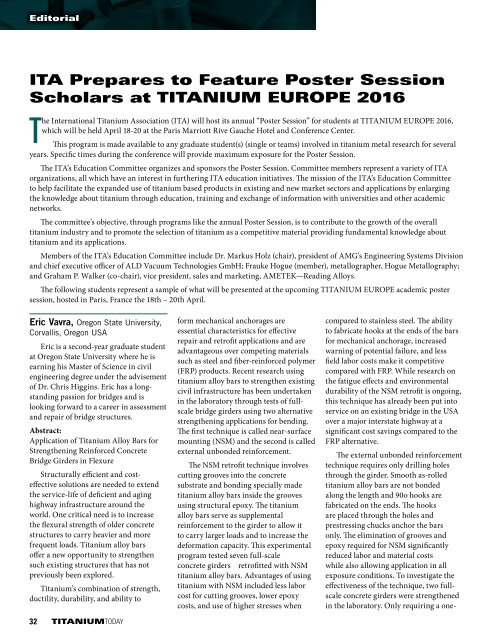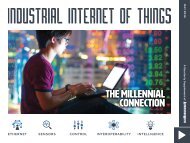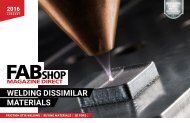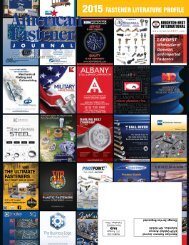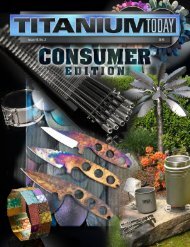100% Positive Material Identification
23mhiW2
23mhiW2
You also want an ePaper? Increase the reach of your titles
YUMPU automatically turns print PDFs into web optimized ePapers that Google loves.
Editorial<br />
ITA Prepares to Feature Poster Session<br />
Scholars at TITANIUM EUROPE 2016<br />
The International Titanium Association (ITA) will host its annual “Poster Session” for students at TITANIUM EUROPE 2016,<br />
which will be held April 18-20 at the Paris Marriott Rive Gauche Hotel and Conference Center.<br />
This program is made available to any graduate student(s) (single or teams) involved in titanium metal research for several<br />
years. Specific times during the conference will provide maximum exposure for the Poster Session.<br />
The ITA’s Education Committee organizes and sponsors the Poster Session. Committee members represent a variety of ITA<br />
organizations, all which have an interest in furthering ITA education initiatives. The mission of the ITA’s Education Committee<br />
to help facilitate the expanded use of titanium based products in existing and new market sectors and applications by enlarging<br />
the knowledge about titanium through education, training and exchange of information with universities and other academic<br />
networks.<br />
The committee’s objective, through programs like the annual Poster Session, is to contribute to the growth of the overall<br />
titanium industry and to promote the selection of titanium as a competitive material providing fundamental knowledge about<br />
titanium and its applications.<br />
Members of the ITA’s Education Committee include Dr. Markus Holz (chair), president of AMG’s Engineering Systems Division<br />
and chief executive officer of ALD Vacuum Technologies GmbH; Frauke Hogue (member), metallographer, Hogue Metallography;<br />
and Graham P. Walker (co-chair), vice president, sales and marketing, AMETEK—Reading Alloys.<br />
The following students represent a sample of what will be presented at the upcoming TITANIUM EUROPE academic poster<br />
session, hosted in Paris, France the 18th – 20th April.<br />
Eric Vavra, Oregon State University,<br />
Corvallis, Oregon USA<br />
Eric is a second-year graduate student<br />
at Oregon State University where he is<br />
earning his Master of Science in civil<br />
engineering degree under the advisement<br />
of Dr. Chris Higgins. Eric has a longstanding<br />
passion for bridges and is<br />
looking forward to a career in assessment<br />
and repair of bridge structures.<br />
Abstract:<br />
Application of Titanium Alloy Bars for<br />
Strengthening Reinforced Concrete<br />
Bridge Girders in Flexure<br />
Structurally efficient and costeffective<br />
solutions are needed to extend<br />
the service-life of deficient and aging<br />
highway infrastructure around the<br />
world. One critical need is to increase<br />
the flexural strength of older concrete<br />
structures to carry heavier and more<br />
frequent loads. Titanium alloy bars<br />
offer a new opportunity to strengthen<br />
such existing structures that has not<br />
previously been explored.<br />
Titanium’s combination of strength,<br />
ductility, durability, and ability to<br />
32 TITANIUMTODAY<br />
form mechanical anchorages are<br />
essential characteristics for effective<br />
repair and retrofit applications and are<br />
advantageous over competing materials<br />
such as steel and fiber-reinforced polymer<br />
(FRP) products. Recent research using<br />
titanium alloy bars to strengthen existing<br />
civil infrastructure has been undertaken<br />
in the laboratory through tests of fullscale<br />
bridge girders using two alternative<br />
strengthening applications for bending.<br />
The first technique is called near-surface<br />
mounting (NSM) and the second is called<br />
external unbonded reinforcement.<br />
The NSM retrofit technique involves<br />
cutting grooves into the concrete<br />
substrate and bonding specially made<br />
titanium alloy bars inside the grooves<br />
using structural epoxy. The titanium<br />
alloy bars serve as supplemental<br />
reinforcement to the girder to allow it<br />
to carry larger loads and to increase the<br />
deformation capacity. This experimental<br />
program tested seven full-scale<br />
concrete girders retrofitted with NSM<br />
titanium alloy bars. Advantages of using<br />
titanium with NSM included less labor<br />
cost for cutting grooves, lower epoxy<br />
costs, and use of higher stresses when<br />
compared to stainless steel. The ability<br />
to fabricate hooks at the ends of the bars<br />
for mechanical anchorage, increased<br />
warning of potential failure, and less<br />
field labor costs make it competitive<br />
compared with FRP. While research on<br />
the fatigue effects and environmental<br />
durability of the NSM retrofit is ongoing,<br />
this technique has already been put into<br />
service on an existing bridge in the USA<br />
over a major interstate highway at a<br />
significant cost savings compared to the<br />
FRP alternative.<br />
The external unbonded reinforcement<br />
technique requires only drilling holes<br />
through the girder. Smooth as-rolled<br />
titanium alloy bars are not bonded<br />
along the length and 90o hooks are<br />
fabricated on the ends. The hooks<br />
are placed through the holes and<br />
prestressing chucks anchor the bars<br />
only. The elimination of grooves and<br />
epoxy required for NSM significantly<br />
reduced labor and material costs<br />
while also allowing application in all<br />
exposure conditions. To investigate the<br />
effectiveness of the technique, two fullscale<br />
concrete girders were strengthened<br />
in the laboratory. Only requiring a one-


